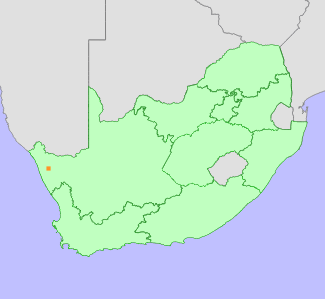|
Scientific Name | Conophytum tantillum N.E.Br. subsp. lindenianum (Lavis & S.A.Hammer) S.A.Hammer |
Higher Classification | Dicotyledons |
Family | AIZOACEAE |
Synonyms | Conophytum lindenianum Lavis & S.A.Hammer |
National Status |
Status and Criteria | Critically Endangered A4d |
Assessment Date | 2021/12/09 |
Assessor(s) | A.J. Young, P.G. Desmet, I. Ebrahim, D. Guo, A. Harrower, L. Jabar, L. Knoetze, C. Rodgerson, P.C.V. Van Wyk & N.N. Mhlongo |
Justification | This succulent is endemic to the Northern Cape province of South Africa with an extent of occurrence (EOO) and area of occupancy (AOO) of 12 km2 where it is only recorded from two locations. The population is experiencing initial levels of decline due to illegal collection for the international trade in ornamental succulents since 2019. Illegal collection is likely to increase as there has been a dramatic increase in the number of species and volume of plants targeted since 2019 including many from the immediate area. The continued threat of illegal collection is therefore regarded as extremely high for this particular taxon and the limited number of locations makes it very susceptible to rapid declines. The relatively small population size of fewer than 2,000 mature individuals means that a decline of at least 90% of the population is very likely within the next thirty years (one generation). While climate change is also highly likely to impact this taxon the rapid declines to the population as a result of illegal collection means it qualifies as Critically Endangered under criterion A4. |
Distribution |
Endemism | South African endemic |
Provincial distribution | Northern Cape |
Range | This succulent is endemic to Namaqualand in the Northern Cape province of South Africa where it is only found in two locations with a severely restricted geographic range. |
Habitat and Ecology |
Major system | Terrestrial |
Major habitats | Namaqualand Klipkoppe Shrubland |
Description | This taxon is endemic to the Namaqualand Hardeveld bioregion of the Succulent Karoo biome. The plants occupy exposed areas of gneiss, often inhabiting sheltered areas, especially the exfoliation joints under rock lips. This taxon has a generation length of 30 years. It is expected to be sensitive to the impacts of climate change as it does not disperse and while adapted to arid conditions, is dependent on limited seasonal rainfall. Species in the genus are sensitive to long periods of drought. Drought related mortality has been observed for other closely related taxa within the genus. |
Threats |
| Plants have been subject to illegal collection of mature individuals for the international trade in ornamental succulents since 2019. As many of the plants confiscated by the authorities in South Africa have only been identified to species level all the subspecies are treated the same here and this taxon is therefore believed to have been collected illegally. This taxon has been sought after by collectors and is highly likely to remain so in future. Related species within the immediate area have experienced severe declines in population number due to illegal collection. The small number of locations and relatively small population size means that this taxon is susceptible to illegal collection. As a result a population decline of up to 95% is suspected over a single generation (30 years). Anthropogenic climate change is a long-term threat to this succulent. Climate models for the likely emission scenarios where emissions stay at present day levels (RCP 2.6) (Hausfather and Peters 2020) and worst case scenarios where emissions continue to increase during the 21st century (RCP 8.5) indicate that there will be a loss of suitable bioclimatic envelope of between 75% and 99% by 2080 for this taxon. Species in this genus have limited dispersal ability and migration to suitable habitats elsewhere is regarded as highly unlikely. |
Population |
This succulent is known from only two subpopulations. There are no formal estimates of population size for this taxon but the number of mature individuals is likely to be fewer than 2,000. The population is experiencing initial levels of decline due to illegal collection for the ornamental succulent plant trade.
|
Population trend | Decreasing |
Assessment History |
Taxon assessed |
Status and Criteria |
Citation/Red List version | | Conophytum tantillum N.E.Br. subsp. lindenianum (Lavis & S.A.Hammer) S.A.Hammer | VU D2 | 2015.1 | | Conophytum tantillum N.E.Br. subsp. lindenianum (Lavis & S.A.Hammer) S.A.Hammer | Least Concern | Raimondo et al. (2009) | |
Bibliography |
Hammer, S. 1991. Tantalus et tantillum. Cactus and Succulent Journal (USA) 63(3):139-141.
Hammer, S. 2002. Dumpling and his wife: New view of the genus Conophytum. EAE Creative Colour, Norwich.
Hammer, S.A. 1993. The genus Conophytum: A conograph. Succulent Plant Publications, Pretoria.
Hausfather, Z. and Peters, G.P. 2020. Emissions - the 'business as usual' story is misleading. Nature 577(618-620).
Opel, M.R. 2004. The rediscovery of Crassula alcicornis. Haseltonia 10:38-40.
Raimondo, D., von Staden, L., Foden, W., Victor, J.E., Helme, N.A., Turner, R.C., Kamundi, D.A. and Manyama, P.A. 2009. Red List of South African Plants. Strelitzia 25. South African National Biodiversity Institute, Pretoria.
|
Citation |
| Young, A.J., Desmet, P.G., Ebrahim, I., Guo, D., Harrower, A., Jabar, L., Knoetze, L., Rodgerson, C., Van Wyk, P.C.V. & Mhlongo, N.N. 2021. Conophytum tantillum N.E.Br. subsp. lindenianum (Lavis & S.A.Hammer) S.A.Hammer. National Assessment: Red List of South African Plants version 2024.1. Accessed on 2025/12/02 |
 Comment on this assessment
Comment on this assessment


